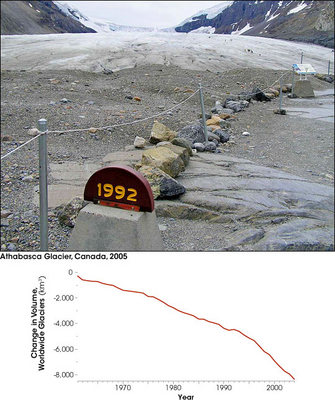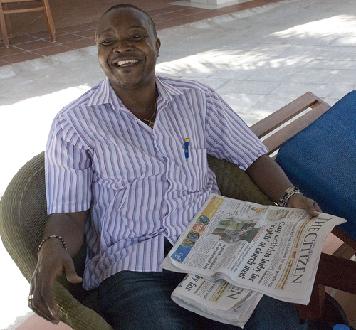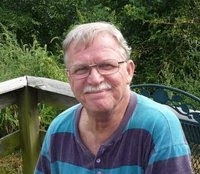
That which man acquires by contemplation he should spend in love.
---Meister Eckhardt
All know that the drop merges into the ocean, but few know that the ocean merges into the drop.
---Kabir
Everybody talks about the weather, but nobody does anything about it.
---Mark Twain, August 27, 1897
Mark Twain's famous remark remained funny for about a hundred years. Then we began to wonder. With all our technology, why can't we change the weather in some places if we want to? But at the same time, gloomier forecasts were accumulating that in fact humanity, in that same hundred years of industrialization, was changing not only the weather but the very stability of the planet's current climate arrangement. We've had at least 10 years of raging argument about this, and still we have "scientists," mostly in the pay of corporations who can't find a profit motive yet, who tell us it all is too complicated for people to understand and it's better to do nothing. Most people, in the States anyway, seem to believe there's global warming or whatever we end up calling it, but feel it's too big for them to change any behavior about. I mean, what is one guy supposed to do?
On Tuesday, the government's NASA site called Earth Observatory put up the 2005 photo you see here with this comment:
"Perhaps the most visible sign that Earth’s climate is warming is the gradual shrinking of its glaciers. In North America, the most visited glacier is the Athabasca Glacier, one of six glaciers that spill down the Canadian Rockies from the Columbia Icefield in western Canada. Visitors who return to the glacier a few years after their first visit will notice the change wrought by warming temperatures. In the past 125 years, the Athabasca Glacier has lost half of its volume and receded more than 1.5 kilometers (0.93 miles), leaving hills of rock in its place. Its retreat is visible in this photo, where the glacier’s front edge looms several meters behind the tombstone-like marker that indicates the edge of the ice in 1992. The Athabasca Glacier is not alone in its retreat: Since 1960, glaciers around the world have lost an estimated 8,000 cubic kilometers (1,900 cubic miles) of ice. That is approximately enough ice to cover a two-kilometer-wide (1.2 mile-wide) swath of land between New York and Los Angeles with an ice sheet that is one kilometer (0.62 miles) tall.
"Melting glaciers, dwindling sea ice, rising global temperatures, and rising sea levels. Little by little the evidence is adding up to show that Earth is getting hotter, and scientists are almost certain that people are to blame. A number of activities from burning fossil fuels to farming pump heat-trapping gases—greenhouse gases—into the atmosphere. Once in the atmosphere, these gases stay there for thousands of years, absorbing the heat that comes from the Earth and re-radiating it back to the surface, enhancing Earth’s natural greenhouse effect. Between 1906 and 2006, the average surface temperature of the Earth rose 0.6 to 0.9 degrees Celsius (1.08 to 1.62 degrees Fahrenheit), while greenhouse gas concentrations reached their highest levels in at least the past 650,000 years. Most climate scientists believe that there is a connection and warn that if greenhouse gas emissions continue, temperatures are likely to go up 2 to 6 degrees Celsius (3.6 to 10.8 degrees F) by the end of the 21st century.
"While this might seem like a small change, it will probably lead to big changes in the environment. Warming temperatures will likely lead to more frequent heat waves, bigger storms, including more intense tropical cyclones (hurricanes), and more widespread drought. Since water expands as it heats, and melting glaciers and ice caps have dumped more fresh water into the world’s oceans, sea levels have already started to rise. Higher sea levels lead to more erosion and greater storm damage in coastal areas, many of which are densely populated. As much as 10 percent of the world’s population lives in vulnerable coastal regions that have an elevation less than 10 meters (32 feet) above sea level."
http://earthobservatory.nasa.gov/Newsroom/NewImages/images.php3?img_id=17644At that point, in a move not at all typical of this site---and I visit it everyday---the reader is referred to another page where begins a lengthy treatise on Global Warming. It is illustrated with many striking photos, maybe most of them taken from satellites circling the Earth.
http://earthobservatory.nasa.gov/Library/GlobalWarmingUpdate/ Well, it's a dot gov site, so where's the policy? Must we wait for the dot coms to sell us stuff to solve it? How organized are all the dot orgs? Is the species finished?
Groups are beginning to meet across the land, many of them in churches, and the concern seems to be the first issue since 9/11 that crosses all political boundaries. They've spent the last year looking at the videos and DVDs and hearing the speakers, and now comes the time to figure out what to do. At just this moment, a writer named Garret Keizer from up in Vermont has gotten an essay published on the Notebook page of the June Harper's. Put his name with "climate" into Google this morning, and stand back. I think the magazine arrived in our mailbox the same day Earth Observatory put up that photo, and already the Internet is buzzing about what this guy's got to say. Essentially his message is nothing could be worse than if liberals trot out their usual package of reforms, then go back to their decks and patios overlooking the manicured sward, and end up wondering in 20 years why everything is worse than before. Harper's undoubtedly will get this essay online, but they like to wait a couple weeks so that people actually give them some money at the newsstands. Bits and pieces already are emerging in the blogs and I'll give you a taste of those excerpts in a minute. But first, who is this Keizer dude?
A fairly detailed outline of his life appeared a couple years ago in the Vermont "alternate web weekly" called Seven Days.
http://www.sevendaysvt.com/features/2004/gladtohelp0.html Here we learn he grew up in New Jersey, attended the University of Vermont where he got a master's in English, and settled around Burlington, where he taught the subject in high school for 17 years. In the meantime he married a Catholic girl and, not wanting particularly to abandon his Protestant perspective, he got her to attend the Episcopal Church. They asked him to give a sermon and then to take charge of some services, and eventually the church ordained him, even though he never went to divinity school, so he could manage activities in some outlying parishes. He quit teaching partly because of all this, and his own writing became increasingly involved with morality. Christianity Today has 35 articles by him.
http://ctlibrary.com/search.html?query="Garret Keizer"&x=10&y=5 In his mid 50s, Garret Keizer may find his quiet life around the Vermont town common suddenly disturbed by the kind of notoriety you get when you seriously rock the boat.
Here are some sections from his essay Climate, Class, and Claptrap~~~
This pretense of not knowing what every idiot knows has increasingly come to define our national discourse. To say, by way of example, that it has characterized the protracted denial of global warming is to understate the point. It also characterizes the burgeoning acknowledgment of global warming, the willingness to grant that a crisis exists even as our key players scramble to guarantee that every systemic cause of that crisis remains intact. It characterizes our farcical debate over the timetable for the withdrawal of US troops from Iraq even as permanent bases are constructed in that country to oversee the flow of its denationalized oil to our national snout. More than anything else, it characterizes our official take on wealth and class, a blind spot as large as any hole in the ozone. ...
...
But I shall be accused of dancing around the most important issue of our time, the issue at the name of which every knee shall bow. Global warming, we are told, will have its most devastating effects on the worlds' disadvantaged. Therefore, we need not care so particularly about the world's disadvantaged; we need only care about global warming -- as mediated, of course, by those who stand to make a bundle off it ...
...
Am I too irreverent? Am I not aware that polar bears are drowning in the Arctic? I am very much aware, and very grieved as well. I am also aware, thanks to book after book by Jonathan Kozol, that children are drowning in our inner-city schools and have been drowning there year after year and decade after decade, but I do not recall anything like the universal lament that has met the drowning scene in An Inconvenient Truth. Then again, the polar bear depicted in that movie has two incontrovertible advantages over Kozol's kids: it's digital and it's white ...
...
The intestinal tipping point came for me when a contingent of students from Middlebury College (annual tuition and fees $44,330) found both the gas money and the gall to drive to the town of Sheffield (annual per-capita income $13,277) in order to lecture the provincials on their responsibility to the earth and its myriad creatures. Not to be outdone, a small private school in our area (annual tuition and fees $76,900) has challenged the wind projects as a source of noise disturbance for its special-needs students. This could actually turn the tide. Like a bookie assessing the hindquarters of horses, I've learned to place my bets with a sharp eye on tuition and fees. Don't tell me where you went to school; just tell me what it cost.
...
Gore speaks of the need for "a different perspective" ... But this is the old perspective: the race to the moon, the triumph of the will, the forward march of progress on a goosestep and a prayer. The unquestioned belief that the answer to every human dilemma and desire is a gizmo -- in short, the very attitude that gave us global warming to begin with. Those measuring the ice shelf in Greenland would do well to spend a few weeks measuring the time that typically elapses between any mention of conservation and the quick segue to something sexier; that is, to something you can buy or sell. The abolition of obscene excess, the equitable distribution of finite resources -- these have the same appeal for our movers and shakers as adopting a crack baby has for the infertile members of their club. We have all these wonder-working technologies, all these clever schemes for producing the golden eggs -- or you could always take home little Bernice. But that's going to be a lot of work.
The bottom line here is, as always, the bottom line, already being parsed out in prospectus form for the eco-savvy investor. ... Gregg Easterbrook, writing in the April issue of The Atlantic, is less of a prig. The question he invites us to ask in regard to climate change -- "What's in it for me?" -- is "neither crass nor tongue-in-cheek," he assures us. Much of what's in it for you (that is, if you happen to be affluent, educated, etc.) will come in the form of carbon trading, a shell game allowing polluters to purchase "offsets," in green-energy production, which may or may not come to include nuclear power ...
...
Presumably this is not the same greed that inspired ExxonMobil to wage a campaign of disinformation about climate change. Presumably we might also consider redirecting the primal human impulse of hate. We could get the Ku Klux Klan to buy "offsets" for lynchings in Mississippi ... It's the Devil's old remedy: If you're being poisoned to death, try taking more poison.
...
... It is not enough to acknowledge that global warming exists; we also need to ask what global warming means. Surely one thing it means is that a culture that has as its highest aim the avoidance of anything remotely resembling physical work must change its life
... But that is only half a meaning, less than half. We're told that "that science is all in on global warming" and that it's just about unanimous. ... But the science has also been in, and in for a while, and is every bit as unanimous in concluding that we are members of a single species, descendents of common ancestors -- family in every conceivable sense of the word. How can we imagine that we will address one overwhelming consensus of scientific opinion without having acted fully on the other? ...
To put that as succinctly as possible, the days of paradise for a few are drawing to a close. The game of finding someone else in some convenient misery to fight our wards, pull our rickshaws, and serve as the offset for our every filthy indulgence is just about up. It is either Earth for all of us or hell for most of us.
...
Those excerpts are taken from a blog that Grist runs, and as of this morning there are 46 comments raging there.
http://gristmill.grist.org/story/2007/5/12/02418/8290 Since other bloggers are having a similar experience, maybe a dialogue will start right here. Here's Harper's to watch for the post online
http://www.harpers.org/ .




